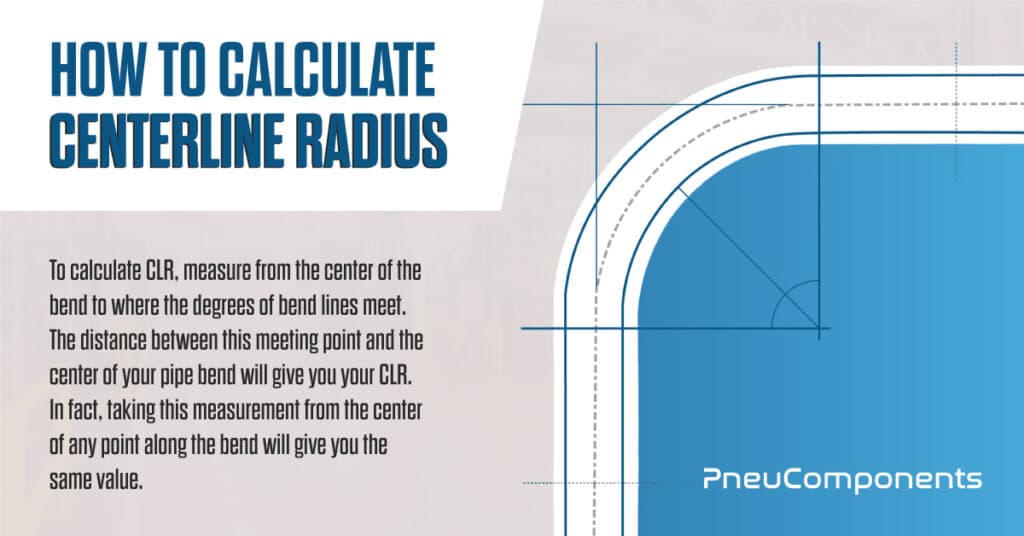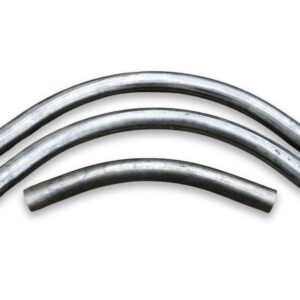Pneumatic conveying is full of technical terms that can make it difficult to comprehend. Even experts can get mixed up between two relatively simple terms when they’re so similar. And in our experience, conversations about centerline radius (CLR) vs bend radius can often lead to confusion.
If you research these two terms, you might struggle to find a concrete distinction. That’s because CLR and bend radius are the same thing.
Knowing this makes it a lot easier to use resources that prefer one term over the other (personally, we use CLR). But there’s still a lot about centerline radius/bend radius that you need to understand to design, maintain, and operate your pneumatic conveying system effectively.
What is centerline radius?
The CLR, or bend radius, is the distance between the precise center of a bend’s curve to the centerline of the pipe. This value is expressed as a number multiplied by the pipe size. For example, a CLR of 2.5D means it’s 2.5 times the pipe’s outer diameter (OD). So a 4” OD 90-degree bend with a 2.5D CLR will have a bend radius of 10” (4” x 2.5 OD = 10”).
The lower the multiple of the pipe size, the tighter the bend radius will be. For example, a pipe with 1.2D CLR will have a tighter bend radius than a pipe with 1.5D CLR.
Why is it important to know your centerline radius?
Whether you’re replacing a single component or designing a whole new system layout, you need to have correct measurements for your bends. That includes degree, line size, tangential points, and, of course, CLR.
CLR helps you figure out the space into which a bend needs to fit within your pneumatic conveying system. A bend that’s too small simply won’t fit, and one that’s too big – even by a tiny amount – can cause leaks, pressure drops, and increases in power consumption and costs.
Purchasing and replacing an incompatible bend costs you time and money that you simply don’t need to waste. So be sure to measure your bend’s CLR correctly the first time and keep a log of your measurements to order well-fitting parts again in the future.
How to calculate centerline radius
To calculate CLR, measure from the center of the bend to where the degrees of bend lines meet. The distance between this meeting point and the center of your pipe bend will give you your CLR. In fact, taking this measurement from the center of any point along the bend will give you the same value.

Boost system efficiency and longevity with high-quality bends
Once you’ve calculated the CLR of a particular bend, you can replace it with a suitable part. But accurate measurements are just one part of building a well-functioning system. You also need to find durable, reliable components in a material that suits your dry bulk product and operational conditions.
Using the PneuComponents online store, you can order industry-leading pneumatic conveying bends in stainless steel, carbon steel, and aluminum with just a few clicks. For each one, you can customize the OD, gauge/schedule, degree, CLR, and tangents to get the perfect fit for your system. And if we don’t have the parts you need in our online store, we can custom manufacture them to your specifications.
Browse our pneumatic conveying bends or get in touch with our expert team to source high-quality parts for your dry bulk materials handling system.
As a part of Progressive Products, Inc, PneuComponents draws on over 40 years of technical expertise and industry innovation to give you the best possible guidance and service. Progressive Products is an industry-leading manufacturer of abrasion-resistant components, and their products are used in pneumatic conveying systems worldwide.
-
Stainless Steel Bends$54.42 – $376.47
-
Carbon Steel Bends$22.83 – $198.45
-
Aluminum Bends$16.57 – $124.62



